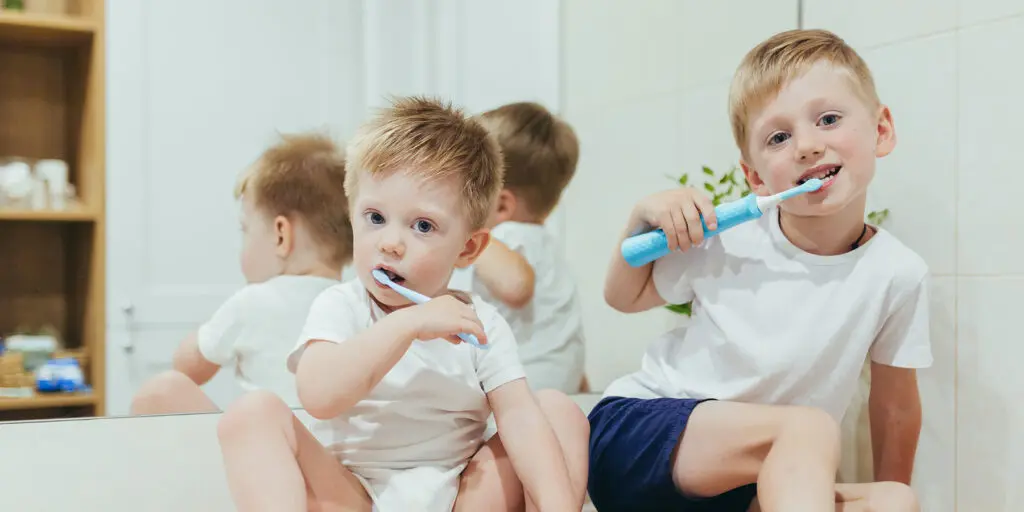Reviewed by Dr. David Sentelle
Parents often ask if electric toothbrushes are better for kids than manual ones. Both can keep teeth clean and healthy, it really depends on what your child feels most comfortable using. The goal is to make brushing easy and consistent every day.
Table of Contents
Key Takeaway
There’s no single best toothbrush for every child. Whether electric or manual, the right one is age-appropriate, comfortable, and encourages consistent brushing habits.
The Right Time to Introduce an Electric Toothbrush
Electric toothbrushes can make brushing more fun and effective, but not every child is ready right away.
For most kids:
- Ages 4–5+ can start with a small, child-sized electric toothbrush.
- Look for one with soft bristles and a gentle vibration setting.
- Some kids may dislike the vibration or tickling sensation and that’s perfectly fine!
If your child prefers a manual brush, there’s no need to switch. What matters most is that they brush twice daily for two minutes with fluoride toothpaste.
Manual Toothbrushes Still Work Great
Manual toothbrushes remain an excellent choice for kids, especially when used with the right technique and supervision.
Here’s what to look for:
- A small brush head that comfortably fits your child’s mouth.
- Soft, rounded bristles that are gentle on gums.
- Replace the brush every three months or sooner if the bristles fray.
Even without batteries or buzz, a well-used manual brush can be just as effective as an electric one.
| 🦷🪥What matters most is not the type of toothbrush but how your child brushes and how often. As a general rule, once a child can tie their own shoes, they are ready to brush without supervision. |
4 Things to Look For When Choosing a Toothbrush
Choosing the right toothbrush helps make brushing safe, comfortable, and effective for your child.
Look for:
- The ADA Seal of Acceptance to ensure safety and quality.
- A small brush head that fits comfortably and reaches the back molars.
- Soft bristles that are gentle on gums and enamel.
- A fun design or favorite character to keep kids interested.
Popular options like Oral-B Kids and Sonicare for Kids come in child-sized designs with gentle vibrations and bright colors that make brushing enjoyable. A good toothbrush helps build healthy habits, especially when paired with encouragement and praise.
Brushing Tips for Kids
Even the best toothbrush won’t do much without proper technique. Keep brushing simple and consistent with these steps (and feel free to reference the ADA brushing guide video):
- Hold the brush at a 45° angle to the gumline
- Brush in gentle circles on all tooth surfaces
- Don’t forget the back teeth and tongue
- Brush for two full minutes, twice a day
Brushing alongside your child or using a timer can make the process more fun and effective. You can also download and print our teeth brushing tips to display in your bathroom.
Building Healthy Habits Early
Whether you choose an electric or manual toothbrush, the goal is the same: clean teeth, healthy gums, and confident smiles.
At Lonestar Kid’s Dentistry, we help parents choose tools and routines that work for their child’s needs and personality. Regular checkups and professional cleanings complete the picture for lifelong dental health.
To book an appointment at our pediatric dental office in McKinney, TX, call (214) 436-5555, request an appointment online or visit us at 5323 W University Dr #100, McKinney, Texas.
📍Other locations
Lonestar Kid’s Dentistry in Frisco, TX
Lonestar Kid’s Dentistry in Prosper, TX
FAQ
Most kids can start around age 4–5, once they can hold the brush comfortably and handle the gentle vibration. For younger children, a baby toothbrush with a small, soft head works best to introduce good oral hygiene habits early.
Both manual and electric toothbrushes can effectively reduce tooth decay when used correctly. Electric options may help with more consistent cleaning, supporting overall oral health, especially for kids who tend to rush through brushing.
Every three months, or sooner if the bristles look frayed. Replacing the brush helps protect tooth enamel and maintain good oral care. Also, always replace a toothbrush after your child has been sick.
Yes, but each child should have their own brush head to prevent bacteria transfer. Sharing is never recommended because it can spread germs between siblings.
